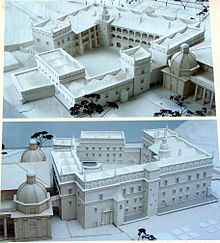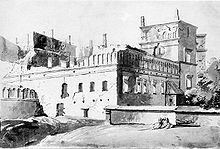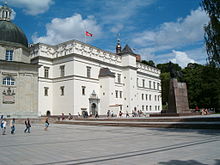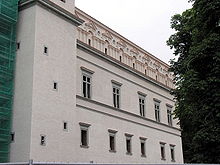- Palace of the Grand Dukes of Lithuania
-
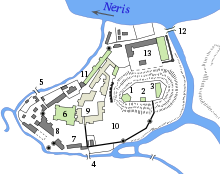 Castles of Vilnius in 1740.
Castles of Vilnius in 1740.
Upper Castle: 1. Western tower; 2. Southern tower (foundations remaining); 3. Palace (ruins remaining)
Lower Castle: 4. Gates and bridge to the city (Pilies Street); 5. Road and bridge to a Tilto street; 6. Cathedral; 7. Palace of Supreme Tribunal; 8. Palace of bishops; 9. Royal Palace; 10. Palace garden; 11. Palace building, arsenal since the late 18th century, currently museum; 12. North-eastern tower and gates of arsenal; 13. Yard of arsenalThe Royal Palace of Lithuania (Lithuanian: Valdovų rūmai) was a palace in Vilnius, Lithuania, built in the 15th century for the rulers of the Grand Duchy of Lithuania. The Royal Palace in the Lower Castle evolved over the years and prospered during the 16th and mid-17th centuries. For four centuries the Palace was the political, administrative and cultural center of the Grand Duchy of Lithuania. It was demolished in 1801. A new palace has been under construction since 2002 on the site of the original building. The partially completed palace was opened on 6 July 2009.
Contents
History
In the 13th and 14th centuries there were stone structures within the palace site; some archeologists believe that a wooden palace stood there as well. The stone Royal Palace was built in the 15th century, apparently after the major fire in 1419. The existing stone buildings and defensive structures of the Lower Castle, which blocked the construction, were demolished. The Royal Palace was built in Gothic style. The Keep of the Upper Castle, as well as the Royal Palace, were meant to host the coronation of Vytautas the Great. The Gothic palace had three wings; research suggests that it was a two-story building with a basement.[1]
The Grand Duke of Lithuania Alexander, who later became King of Poland, moved his residence to the Royal Palace, where he met with ambassadors. He ordered the renovation of the palace. After his marriage to a daughter of Moscow's Grand Duke Ivan III, the royal couple lived and died in the palace.
Sigismund I the Old, after his ascension to the Grand Duchy of Lithuania, conducted his affairs in the Royal Palace as well as in Vilnius Cathedral. During the rule of Sigismund I the palace was greatly expanded, to meet new needs of the Grand Duke – another wing was added, as well as a third floor; the gardens were also extended. By contemporary accounts the palace was worth 100,000 ducats.[2] The palace reconstruction plan was probably prepared by Italian architect Bartolomeo Berrecci da Pontassieve, who also designed several other projects in the Kingdom of Poland. In this palace Sigismund the Old welcomed an emissary from the Holy Roman Empire, who introduced Sigismund to Bona Sforza, his second wife, in 1517.
Sigismund's son Sigismund II Augustus was crowned Grand Duke of Lithuania in the Royal Palace. Augustus carried on with palace development and lived there with his first wife Elisabeth of Austria, daughter of the Emperor of the Holy Roman Empire. She was buried in the Vilnius Cathedral.[3] Sigismund II's second wife, Barbara Radziwill, also lived in the palace. According to contemporary accounts of the Holy See's emissary, the Royal Palace at that time contained more treasures than the Vatican.[4] Sigismund II also assembled one of the largest collection of books and tapestries in Europe.[4]
The palace was remodeled in the Renaissance style in the 16th century. The plan was prepared by several Italian architects, including Giovanni Cini da Siena, Bernardino de Gianotis Zanobi, and others. The palace was visited by Ippolito Aldobrandini, who later became Pope Clement VIII. Another major development took place during the reign of the Vasa family. The Royal Palace was refurbished in early Baroque style during the rule of Sigismund III Vasa. Matteo Castello, Giacopo Tencalla, and other artists participated in the 17th century renovation.
During the rule of Vasas, several notable ceremonies took place in the palace, including the wedding of Duke John, who later became King John III of Sweden, and Sigismund Augustus' sister Catherine. The first opera in Lithuania was staged in the palace in 1634.[5] Marco Scacchi and Virgilio Puccitelli were the opera's impresarios.
After the Russian invasion in 1655, the state began weakening, and that negatively affected the Royal Palace. In August 1655, Vilnius was captured by the Muscovite army. The Polish-Lithuanian army recaptured the city six years later, by which time the palace had been destroyed by fire. The palace was greatly damaged and its treasures were plundered. After the recapture of the city of Vilnius in 1660-1661, the palace was no longer a suitable state residence, and stood abandoned for about 150 years. In the late 18th century, after the fall of the Polish-Lithuanian Commonwealth, several families lived in parts of the ruined palace. Soon after the Grand Duchy of Lithuania was incorporated into Tsarist Russia, Tsarist officials ordered the demolition of the remaining sections of the Royal Palace.[5] The Palace was almost completely demolished in 1801, the bricks and stones were sold, and the site was bowered.
Only a small portion of the walls up to the second floor survived, that were sold to a Jewish merchant Abraham Schlossberg around 1800 who incorporated them into his residential house. After the 1831 uprising, the czarist government expelled Schlossberg and took over the building as it was building a fortress beside it. Before the Second World War it was the office of the Lithuanian Army, during the World War II it was the office of the German Army, and after WWII it was used by Soviet security structures and later transformed into the Palace of Pioneers. Fragments of Schlossberg's house have become part of the Eastern Wing of the restored Royal Palace. [6]
A new palace has been under construction since 2002 on the site of the original building. The Royal Palace was officially opened during the celebration of the millennium of the name of Lithuania in 2009, although not yet completed due to the lack of necessary funding.
Criticism of the reconstruction
 Litas golden coin dedicated to the palace
Litas golden coin dedicated to the palace
Historians, who were against reconstruction, provided many arguments why reconstruction of Royal Palace was unnecessary. It was argued that the newly built Palace would destroy the urban landscape formed over the last 300 years. Vilnius Cathedral would be overshadowed by the Royal Palace, and the Gediminas' Tower would not be visible from the side of the cathedral. Materials and technologies unknown at the time of original construction have been used. The construction of the replica of the Royal Palace was financed by the State while many historic authentic buildings are in critical condition. [7]
References
- ^ (Lithuanian) Napaleonas Kitkauskas (2004). "Italy in Lithuania.". http://www.lithill.lt/vic-italy/article6.asp. Retrieved 2007-01-21.
- ^ (Lithuanian) Jovaiša, Eugenijus (2003). Lietuvos istorijos vadovėlis/Vilniaus pilys. Vilnius. ISBN 9986-9216-9-4.
- ^ (Lithuanian) Lietuvos Dailės muziejus. "Arkikatedros požemiai". Archived from the original on 2007-01-07. http://web.archive.org/web/20070107031723/http://ldmuziejus.mch.mii.lt/Muziejusirpadaliniai/Arkikatedra.htm. Retrieved 2007-01-21.
- ^ a b (Lithuanian) Lithuanian Art Museum. (1997). "Lithuanian Ducal Palace". Archived from the original on 2006-12-05. http://web.archive.org/web/20061205020335/http://ldmuziejus.mch.mii.lt/Muziejusirpadaliniai/Ducal_Palace.en.htm. Retrieved 2007-01-21.
- ^ a b (Lithuanian) Valdovų Rūmų paramos fondas (2002). "Lietuvos Valdovų Rūmai". http://www.lvr.lt/site.php?contentID=14. Retrieved 2007-01-21.
- ^ (Lithuanian) Liucija Abromaitė. Pionierių rūmai koreguoja Valdovų rūmų viziją (Palace of Pioneers corrects vision of Royal Palace). Lietuvos žinios, No. 165 (11502), 22 July, 2006
- ^ (Lithuanian) Audrius Bačiulis. Valdovų rūmai prieš Sapiegų rūmus (Royal Palace versus Sapiegos Palace) , Veidas, 2005.04.21 - No. 16
External links
- The Palace of the Grand Dukes of Lithuania
- Lithuanian Ducal Palace
- Restoration of Royal Palace
- (Lithuanian) Fund Supporting Royal Palace
Coordinates: 54°41′09″N 25°17′22″E / 54.68583°N 25.28944°E
Categories:- Buildings and structures demolished in 1801
- Renaissance architecture in Lithuania
- 15th-century architecture
- Palaces in Vilnius
- Royal residences in Lithuania
- Destroyed landmarks
Wikimedia Foundation. 2010.

